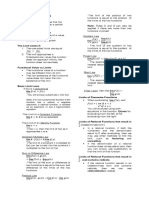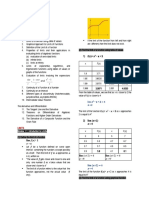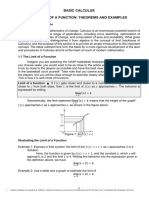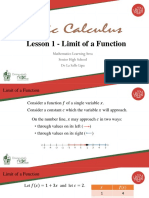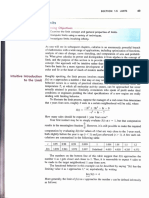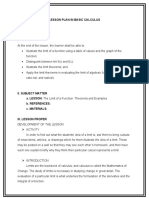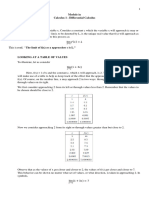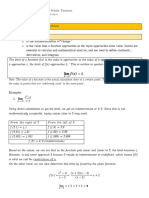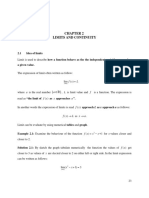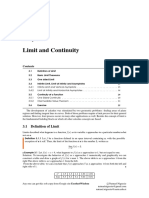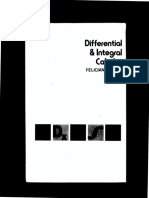0 ratings0% found this document useful (0 votes) 85 views18 pagesBasic Calculus
Copyright
© © All Rights Reserved
We take content rights seriously. If you suspect this is your content,
claim it here.
Available Formats
Download as PDF or read online on Scribd
THE LIMIT OF A FUNCTION
Limits are the backbone of calculus, and calculus is called the Mathematics of Change.
> The study of limits is necessary in studying change in great detail. The evaluation of a particular
limit is what underlies the formulation of the derivative and the antiderivative (indefinite integral)
of a function.
> Let f be a function of a single variable x. Consider a constant c which the variable x will
approach (c may or may not be in the domain of f).
> The limit, to be denoted by L, is the unique real value that f(x) will approach as x approaches
c. In symbols, we write this process as:
lim f(x) =L
xc
> Thisis read, “The limit of f(x) as x approaches c is L”
BULAR METHOD
Exeunple 4: Consider f(: +3. Evaluate limo +3) Excample 2: Evaluate Lim |x|
” x0
x f@) x f@) x I) x I@)
0 3 2 5 zl % 4 4
| 05 35 15 | 48 p OSE | oe p-os_| os
os Ss Pr a a1 | 04 or | on
oor | 001 oor | 001
099 | 3.99 101 | 401 “aot | a0ot 1
0.999 | 3999 ‘001 }, 4.008 0.0001 | 10001 | | a.c001 | 0.0001
0.9999 | 3.9999 | 10001 | 4.0001 0.00001 | 0.00001 0.00001 | 0.00001
0.99999 | 3.99999 1.0001 | 4.00001 Jim|z| = 0 Jim|x| =0
* Observe that as the values of x get closer and © Thus, lim|x| = 0
7x0
closer to 4, the values of f(x) get closer and
closer to 4.
This behavior can be shown no matter what set
of values, or what direction, is taken in
approaching 1
lim (x+3)=4
KINDS OF LIMITS
Ow sided dimite
> If x approaches c from the left, or through values less than c, then jim, fF =Ly�> If x approaches c from the right, or through values greater than c, then
dim (3) = Ly
> Furthermore, we say that lim f(x) = L, if and only if, iim f= jim, f(x)
> In other words, for a limit L to exist, the limits from the left and from the right must
both exist and equal. Therefore lim f(x) DNE whenever Jim ff # Jim, f@
Ce alaal ers ae)
Example 1 Example 2
volute:
lm) ‘ tim f=)
since sree
Jim fx) =4 Jim f(x) =2 x
sim f(x) = 4 ‘Mim fo) =2
Then,
Then,
lim f(x) = 4 fim f(x) =2
Example 3 Excample 4
evahate: P volute: A t
lim g(x) 4 Aim h(x) ‘
ua
Since since x
fim g(x) =4 fpr =-1 ZY (NA
im, g(x) =2 im he) =~
Then, Then, |
tiny 9(2) DNE li a) DE
THE LIMIT OF A FUNCTION AT c VERSUS THE VALUE OF THE FUNCTION AT &
> Critical to the study of limits is the understanding that the value of lim f (x) may be
distinct from the value of the function at x = c, that is, f(c).
> Generally lim f(x) has nothing to do with f(c)!
Example 1
Recall that Lim (x +3)=4�x @ @)
A Z ; = i : Note that the value of the function at
&™ 6AN4?| 2-1 is also equal to4 or f(1) = 4.
05 35 15 | 45 © However, it's not always the case.
0.9 3.9 1.4 44 Consider following function
x+1, ifx>3
0.99 3.99 1.01 4.01 f(x) = S—x,ifx<3
C8 15 1.001 {amy Then, f(3)=4 and lim f(x) DNE
0.9999 | 3.9999 1.0001 | 4.0001 as
0.99999 | 3.99999 1,0001 | 4.00001
BASIC LIMIT THEOREMS
1. Lonstant Rulw 4. Qddition Ruy
> The limit of a constant is itself. If
k is any constant, then limk =
k
Examples:
lim 35 = 3.5 Jim 2- 5° = 2-525
lim x = lim, 2018 = 2018
xt
2. Lduntity Rudy
> The limit of x as x approaches
c is equal to c.
> limx=c
x20
Examples:
lim
5 lim x = -21
lim x = 11
nh
3 Lorstant Multiple Rule
> The limit of a multiple of a
function is the multiple of the
limit of the function
> Ifkis aconstant and
lim f(x) = L then, lim k-
F(@) = ke lim f(x) = kek
For example: Let lim f(x) =
xe
4, lim 3+ fe) = 3: lim f(x) = 3 +4 = 12
2. lim 8- f(x) = 8 lim f(x) = 8-4 = 32
> The limit of a sum of functions is
the sum of the limits of the
individual functions.
> Suppose lim f(x) =Land
lim g(x) = M:
Him[f(x) + g@)] = lim f(z) + lim g(x)
=L+M
For example: Let
lim f(x) = 3 and lim g(x) = ~2
1. lim f@) + lim g@) = 3+ (-2)=4
5. Swhtrartion Rtv
> The limit of a difference of
functions is the difference of the
limits of the individual functions.
> Suppose lim f(x) = Land
x
lim g(x) = M
xc
lim[f@) - g@)
=L
For example: Let
lim f(x) = 3 and lim g(x) = ~2
4. lim f(x) ~ lim g(x) = 3 = (-2)=5
6. Muttiplication Ruy�> The limit of a product of
functions is equal to the product
of their limits.
> Suppose lim f(x) = L and
lim g(x) = M
xc
lim[f (x) - g()]
For example: Let
lim f(x) =5 and lim g(x) =-2
4. lim f(x) - lim g(x) = 5-(-2) = -10
me rae!
7. Division Ruy
> The limit of a quotient of
its, provided
the denominator limit is not
equal to 0.
> Suppose lim f(x) = Land
lim g(x) = M
xe
fd) limf@) 1
tt lg@| limg@) M’
For example: *7¢
1, If lim f(x) = 10 and limg(x) = -5
8. Power Run
> The limit of an integer power p
of function is just the power of
the limit of the function
> Letlim f(x) = L
lim (f(x))?= (lim f(x))?= LP
xe xe
For example
1. If Jim f(x) = -2
lim(FC)* = (im fOO)%= -2)%= -8
21 um re) = $
9. Rodizol Rule
> Ifnisa positive integer, the
limit of the mth root of a function
is just the mth root of the limit of
the function, provided that the
nth root of the limit is a real
number.
> Ihlim f(x) = 1, b> Oifnis
even then
ten FD = “fim fea) = VE
For example:
1 If lim f(x) = 100
ium V7G = flim 7G.) = VI00 = 10
2. Af tim f(a)
1
im F@) = V=T DNE
lim VF
LIMITS OF POLYNOMIAL, RATIONAL
AND RADICAL FUNCTIONS
THEOREM 2
> Let f be a polynomial function of the form:
© f(x) = ayx" + Qy_1X™ 1! + ayy x"? + + aX + Ay
‘fc isareal number, then lim f(x) = f(c)
> Example:�Evaluate:
lim(2x3 — Sx? + 4x ~7)
Solution:
F (2) = 2@)8-8(2)? + 4(2) —
= 2(8) — 5(4) + 4(2)-7
=16-20+8-7=-3
THEOREM 3
> Lethbea pore function of the form
* h@) = a
« Where f and g are polynomial functions. If c is a real number and g(c) # 0, then
£@ _ $0
ot I@® 5)
> Example:
Evaluate: tin 2E+13
ex? 3x45
Solution:
20) +13 15 _
IM =Ge—a@as- 3 75
INDETERMINATE FORM
> Indeterminate Form of Type =
> flim (2) = and lim g(x) = 0 then lim 4 s called an indeterminate form of
co
type
> Note: Indeterminate form is never a final answer!
> Examples: >
x?+x-20
| ge, 2x? = Sx Evaluate: lim ———_—
Evaluate: lim a4 2-yx
Solution: Solution:
2 2
tim 22 5 _ 20)? -5(0) _0 yn ae
rox 0 0 tim we RB 2aye HM Gay
im 2X9 ~ jim(ax - 5) = 2(0)- 5 = -5 G+9R+9 G+92+V) OW)
0X =o fa aa 8�fare LIMITS
Consider the function Similarly, if we let x — [—y—T Fay
f@)=4. Note that ~ >t 4 {approach 0 through = -——\—"
the function is not [as ~} ~~ | Values greater than |} .
defined at x=0 but [—sg—}——10r from the right, we | |
we can describe the observe that the f(x) os | |
behavior of f as x at *°__| values get larger and on 100
approaches 0. 201 | 4900 | larger without bound. foot | voor
eae! ace 001 | 1,900,000
Him f(x) = +2 20001 [00000 | lim f(x) = +00 ‘0.0007 | 100,000,000 |
Since lim f(x) = +00 and lim, f(x) =
We may conclude that lim f(x) = +2
> Note: The symbol co is NOT a number. Infact, it does not hold a specific value. So, only describes
the behavior of the function near x = c, but it does not exist as a real number.
INFINITE LIMITS
> The limit of f(x) as x approaches c is positive infinity, denoted by lim f(x) = +e0
xe
Ifthe value of f (x) increases without bound whenever the values of x get
closer and closer to c.
‘> The limit of f(x) as x approaches c is negative infinity, denoted by lim f(x) = —oo
xe
e Ifthe value of f(x) decreases without bound whenever the values of x get closer
and closer toc.
> |fnis any positive integer, then jim 5 z=teo
1. (+ if n is even
alist Ne foiling TrPARe limits
1
2. lim — =+0
x07 X'
> Suppose lim f(x) = L # 0 andlim g(x) = 0. If:
me x3
i. L > O and g(x) approaches 0 through positive values as x approaches c, then
© tim22 = 400
xe a(x)
ii.L > 0 and g(x) approaches 0 through negative values as x approaches c, then�> Suppose lim f(x) =L+0and lim g(x) = 0. If:
ili. L < O and g(x) approaches 0 through positive values as x approaches c, then
.
iv.L < 0 and g(x) approaches 0 through negative values as x approaches c, then
© limZ2 = 400
xc g(x)
Evaluate the following infinite limits.
2x43 20) +3 5
= = +
1. im aoa @+De-) DO)
2. tim BEAERT _ 3@P42-7 7
* EE Sr— 10 (+ 5)\@—2) TO)
43-1 4
CDE CHO)”
LIMITS AT INFINITY
> If kis any real number and 7 is positive integer, then
© limk=k
iy
Fa
ce
Examples:
1. lim @- 1) =40+4+1=+400
x00
2. lim (x? ~ 2x + 3) = (—28)*-2(—e0) +3
=SOtO+3Z = +0
ae tim (22 =3E*1)
"aS axed)
LIMITS OF TRANSCENDENTAL FUNCTIONS
Limite of Leporantioh k Loyarith min duntions
© Ifb > 0, b # 1, the exponential function with base b is defined by y = f(x) = b*,
xeR
> Letb > 0,b # 1. Ifb¥ =x then y is called the logarithm of x to the base b,
denoted by y = f(x) = log, x
Consider f(x) = 2. Evaluate lim2*
rt The graph ofthe
me ; function ((2)= 2" is
fipzt=4 (x Tf \[ os [ie given at the right,
uy | aw || 29 | tame
po | eu |] 20 | Since,
25 | ser
ae and lim 2
ae Then
201 | 408
lim 2* = 4
toe | ase || 2001 | ames
190 | 397 || 2000 | eens wae es
— ne limit of the exponential function f(s) = 2* can
1.9000 | s.9en07 || 2.0001 | 4.00003 lim 2*=4 10 .aciiy solved by calculating /(c).�> Consider the natural exponential function y = f(x) = e*.x ER
Where e is called the Euler (read “oyler”) number with an approximate value of 2.718.
For example, to evaluate the limit of the natural exponential function f(x) = e* as x > 0 we
use the
°
theorem, lim f(x) = f()
Thus lim e* = e° = 1
x00
Limitof Lei iN ti
>
si
cs
oT
.
Let us obs
{as ¢ approaches 0 from left and right.
Let @ be an angle in standard
position and P(@) = P(x, y) the
point on its terminal side on the
unit circle. The six trigonometric
functions of the angle 6 are given
by y
in@=y cosO=x tan =>
1 x
sco=! seco=t coto=~
y x y
heorem
Let w be an expression defined as an
angle of the trigonometric function
and c be any real constant, then
(provided the limit exists)
lim sinu = sinc lim tanu = tance
lim cosu = cosc
serve the behavior ofthe runcion it) = 2!
The tableshows | ¢ | 10 |{ ¢ | 10
that as ¢ gets i [osas | | esas
doserto 0, the | sl esses] | os] essen
7(0)-values
approach 4 1 | esses [01 | osees
Then, oor | aseeee | eee
sine 2001 | eomme || 0001 | cme
eT? 20001 [ssw | | 0.0008 | orem |
Lat 710 ="=4, then examine the behavior of f(0) a5
fapproacres fe ro |{ e [to
From the table, esa) | ae
we see that at [a5 | ares || 05 | same
oft. |
Then’ we say) 21 | esse || os
at “aot eas | | aot
“coor | e9ee80 =
“20000 | ame || 00000 | soon
t
lim.
0.
> Let x be any real number.
Suppose @ is the angle in standard
position with measure x radians.
Then we define
sinx = sin@ escx = csc
cosx = cos@ secx = sec
tanx =tan@ cotx = coté
> Some special limits
1-cost
FE Ost ig
oot
——= 1 lim
sinter
sint
The graph of /(¢) =~" is illustrated below.
sint
‘The graphs shows that lim="— = 1�CONTINUITY OF FUNCTIONS
> We have seen how the limit of a function as its independent variable x approaches a
number c differs from the actual function value at the number.
> The limit describes what happens to the function f near c, not atc.
> lim f@\s NOT NECESSARILY the same as (c)
CONTINUOUS FUNCTION
> A function f continuous if there’s no hole, gap, or interruption on its graph.
> Generally, a function is continuous at every point if you can trace its entire graph from left
to right without lifting your pen or pencil
> A function f is continuous at x=c if: lim FW~)=FfO
Dh Londitions of Continuity
> A function f is continuous at x=c if it satisfies the three conditions:
i. f(c) exists;
ii. lim f@x) exists
il lim f(x) = FO).
> If one or more of these conditions fail to hold at c, then f is discontinuous at c.
Excunples: ,
- . - -9
1. Given that f(x)=2x+3, is f continuous 2. Let f(x) = 3 Is f continuous at x = 3?
at a=4? Solution:
Solution: i. £(3) ONE
i. (y= ?+4ay-3
A(x) = (1)*+4(1) -3 = 2
(x) = ACI)
G-HR+3)_
M. way = wy
Since f(3) DNE, then f is discontinuous at
Since lim h(x) = h(1) , then h is continuous ves
atr=1.
CONTINUITY ON AN INTERVAL
> A function can be continuous on an interval. This simply means that it is continuous at every
point on the interval.
> Equivalently, if we are able to draw the entire graph of the function on an interval without
liffng our tracing pen, or without being interrupted by a hole in the middle of the graph, then
we can conclude that the function is continuous on that interval.
> Afunction f is said to be continuous from the left at x=c if/() = Jim fG)
A tuncion f is said to be continuous from the right at x=c it (C) = lim, f(x)
Su pumtion is said te by vontinaous ”
a) Everywhere if f is continuous at every real number. In this case, we also say that f is
continuous on R.�b) On (a,b) if f is continuous at every point x in (a,b).
©) On [a,b) if f is continuous on (a,b) from the right at a.
d) On (a,b] if f is continuous on (a,b) from the left at b.
) On [a,b] if f is continuous on (a,b] and [a,b).
f) On (a,+@) ifis continuous at all x>a.
g) On [a,+~) if f is continuous on (a,+) and from the right at a.
h) On (-~,b) ifis continuous at all « A function F is an antiderivative or indefinite integral of the function f on an interval I
if F'(x) = f(x) for every value of x in the interval I.
> Forexample:
© Anaantiderivative of f(a) = 12x? + 2x is F(x) = 4x3 + x?. The derivative of
F is given by F’(x) = 12x* + 2x = f(x)
> The antiderivative F of a function f is not unique.
> In fact, any function of the form F(x) = 4x3 + x? + C where C € Ris an
antiderivative of f (x).
> Theorem:
¢ If Fis an antiderivative or indefinite integral of the function f on an interval J, then
every antiderivative f on I is given by F(x)+C, where Cis an arbitrary constant.
¢ Using the theorem, we can conclude that if F, and F, are antiderivatives of f, then
F,(x) = F,(x) + C. Thats, F, and F, differ only by constant
TERMINOLOGIES & NOTATIONS
Antidifferentiation is the process of finding the antiderivative of a function f.
The symbol J (integral sign), denotes the operation of antidifferentiation.
The function f is called the integrand.
If F is an antiderivative of f, we write J f(x)dx = F(x) +C
The symbols and dx go hand-in-hand and dx helps us identify the variable of integration.
The expression F(x) + C is called the general antiderivative of f. Meanwhile, each
antiderivative of f is called a particular antiderivative of f.
Excample: Given f(x) = 12x? + 2x
eeregse
> Particular Antiderivatives o F(x) =403 +x7 +5
o F(x) =4x3 +x274+2 > General Antiderivative
o F(x) = 4x3 +x2-3 © F(x) =4 42°46
THEOREMS ON ANTIDIFFERENTIATION/ BASIC INTEGRATION FORMULAS�1. fdx=x+C
2. Ifmis any real number and n # —1, then
© fx"dx = a +€
3. If ais any constant and f is a function, then
© faf(x)dx=af f(x)dx
4. If f and g are functions defined on the same J,
© SFC) + a(axidx = f fddx + f g(x)dx
ntl
Example 1: Eveluate the indefinite integral Excvnple 2: Evaluate the indefinite integral
o i P' teg!
JO? —2y+3)dy J(Sxt +2x3 — 6x? + 10x + 3)dx
sotaion: | ytéy—2f iy +3 fay Solution: [sxvar+ | zv'ex—fortac+ { r0ser f sax
wo freta[ mar-ef arse fares fee
=5 542 5-6-5 Peas Searve
542 _as4sxt+ar+c
6. fatdx + CHere,a > Owitha #1
Ina
1. [xtdx = f2dx = In|[x| +
Example 3: Evaluate the indefinite integral Example 4 Evaluate the indefinite integral
J (es? +31) ax j CS) ax
jon: { ex lie [5x71 3 apr
Solution: Je des f3 dx fs dx Solution: [(G-3-3+3+S8)u
op ee
net fertra3 (3: e
SG . dx +3 [ress dx = [mtx [2ar— fx ‘ars [rts fea
2
L 23 x 1
Sinjri+ C=" o Sin|xi+C =F -2e-Injx|-2 +6
Antidarivatiour ef ri ON A
8. fsinxdx =-—cosx+C
9% fcosxdx=sinx+C
10. f sec? xdx = tanx+C€
11. f esc® xdx = —cotx+C
12. f secx tan x dx = secx+C
13. f ese x cot x dx = —cscx + €
Exewnple 5: Evaluate the antiderivative
ea
sete™t
2
Stan? xdx Identity: seex = stan x = tt
Identity: tan? x= sec? x =1 o
1 sn 4 fs tanxdx = secx+€
a 2,11 Si rane — -—dx = | secxtanxdx =
[eae xdx Jets 1dr sec xdx fac paren
= tanx-x+C�TECHNIQUES OF INTEGRATION
INTEGRATION BY SUBSTITUTION
> Suppose we are given an integral of the form
© SF(g())g'@ax
> We can transform this into another form by changing the independent variable x to u using
the substitution wu = g(x). In this case, a = g'(z). Therefore,
© Sf(g@)g'@adx = ffwdu
‘> This change of variable is one of the most important tools available to us. This technique is
called integration by substitution.
> Usually, we make a substitution for a function whose derivative also occurs in the
integrand. For example,
ern of 3e— te
Joe ~ 4x)*(6x—#)ax
red)
Exewnple 1: Evaluate the indefinite integral
J SV4-+¥ Sxdx
au
Solution: Let u=4+5x, == 5 or du =Sdr
[oa + Sxdx =f + 5x)? Sdx afer du
Using the format: [wren =
wan se asa
wt Ce eC EES g
“ari 3 3
_ANTIDERIVATIVES / INTEGRALS
fostxar=-cotr+
a
ord
J
J [rcromdis Dacrs
fora
J
J
I
J
sinsdx = [ecexds= nisin! +0
cosrérssin +c fomédenhtemcetonaic
[oerere mieck wert
Example 2: Evaluate the indefinite integral
SQ - 1)" a.
USING SUBSTITUTION RULE
fe
Iul + frapwau=1n|secul +c
udu -eseu +
Jooude=-cosu+e —— [cotudu=tnysinul+c
fie




